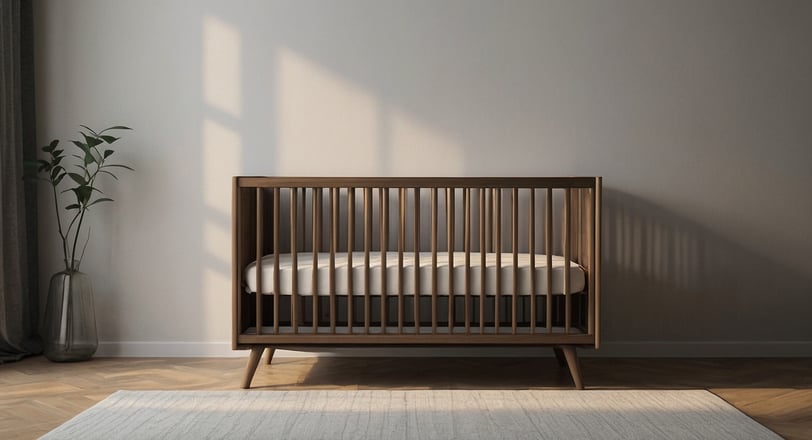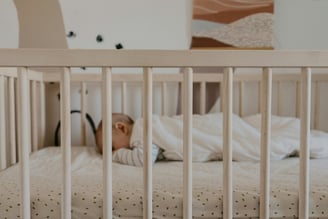Choosing the Perfect Wooden Baby Crib
Discover everything you need to know about selecting the ideal wooden baby crib for your nursery. Learn about essential safety features, various styles, and the numerous benefits of wooden cribs to ensure a safe and cozy space for your baby.


Choosing the right wooden baby crib is one of the biggest decisions when preparing for your little one’s arrival. It’s not just a piece of furniture—it’s the heart of the nursery, the spot where your baby will sleep, dream, and grow. I believe a crib isn’t just about safety (though that’s obviously a top priority); it’s also about creating a cozy, comforting space that feels just right for the baby—and for you. So if you're interested, you can Learn more about wooden baby cribs here to ensure you’re making the best choice for your family.
What to Look for in a Wooden Baby Crib
Selecting the perfect wooden baby crib involves more than just picking a design that matches your nursery. It’s essential to consider safety, durability, and practicality to provide your baby with the best sleeping environment.
1. Safety Features
Safety is the top priority when purchasing a wooden baby crib. Look for cribs that meet current safety standards, such as those set by the Consumer Product Safety Commission (CPSC). Ensure the crib’s slats are no more than 2 3/8 inches apart to prevent your baby’s head or limbs from getting stuck. Avoid cribs with drop-side rails, as they are no longer considered safe.
2. Sturdy Construction
A sturdy wooden baby crib ensures long-term durability and keeps your baby safe. High-quality hardwoods like oak, maple, or birch are excellent choices for their strength and resistance to wear and tear. Check that the crib is free from sharp edges or splinters and that it has a stable, wobble-free frame.
3. Adjustable Mattress Heights
Many wooden baby cribs feature adjustable mattress heights, which are convenient for parents. You can position the mattress higher for easier access to your newborn, then lower it as your baby grows and becomes more mobile. This feature helps prevent climbing accidents as your child becomes more active.
4. Eco-Friendly and Non-Toxic Finishes
For parents concerned about sustainability and safety, a wooden baby crib made with eco-friendly materials and non-toxic finishes is a great choice. Look for certifications such as Greenguard Gold, which ensures the crib meets strict chemical emissions standards.
5. Style and Design
The wooden baby crib you choose should complement the overall theme of your nursery. Whether you prefer a classic, modern, or rustic style, there are plenty of options to suit your taste. Neutral wood tones are a versatile choice, and they can be paired with a variety of nursery colors and decor.
Types of Wooden Baby Cribs
There are several types of wooden baby cribs to choose from, each offering unique features to meet your family’s needs.
Standard Wooden Baby Crib
The standard wooden baby crib is a timeless option. Its simple yet functional design makes it an ideal choice for many families. These cribs are widely available and often come at an affordable price.
Convertible Wooden Baby Crib
A convertible wooden baby crib grows with your child, transitioning from a crib to a toddler bed, daybed, or even a full-sized bed. While they may have a higher initial cost, their versatility can save money in the long run.
Mini Wooden Baby Crib
For families with limited space, a mini wooden baby crib is a compact alternative. These cribs are perfect for apartments or small nurseries and can also serve as a secondary crib for travel or grandparents’ homes.
Portable Wooden Baby Crib
A portable wooden baby crib features wheels for easy movement around your home. This option is great for parents who want flexibility in their baby’s sleeping arrangements.


Setting Up Your Wooden Baby Crib
Once you’ve chosen your wooden baby crib, it’s important to set it up properly to create a safe sleeping environment for your baby. Follow these tips to ensure everything is ready:
Assemble Carefully: Follow the manufacturer’s instructions when putting together your crib. Double-check that all screws, bolts, and components are securely fastened.
Choose the Right Mattress: Use a firm mattress that fits snugly within the crib, leaving no gaps along the edges.
Avoid Loose Bedding: For safety reasons, do not place pillows, blankets, or stuffed animals in the crib. Instead, opt for a fitted crib sheet specifically designed for your wooden baby crib.
Position Safely: Place the crib away from windows, blinds, and cords to prevent accidents. Keep the surrounding area free of small objects or choking hazards.
Inspect Regularly: Check your wooden baby crib regularly for any signs of damage, such as loose screws or chipped finishes. Repair or replace parts as needed to maintain its safety and stability.
Benefits of a Wooden Baby Crib
A wooden baby crib offers numerous benefits for both parents and babies, making it a worthwhile investment for your nursery.
Timeless Appeal: Wooden cribs have a classic, elegant look that never goes out of style. They can easily blend with any nursery theme or decor.
Durability: High-quality wooden baby cribs are built to last, often surviving multiple children and years of use.
Eco-Friendly Options: Many wooden cribs are made from sustainably sourced materials, making them an environmentally conscious choice.
Comfort and Safety: A well-constructed wooden baby crib provides a safe and cozy sleeping environment, promoting better sleep for your baby.
Frequently Asked Questions
1. When should I transition my baby out of a crib?
Most babies transition out of a crib around 2 to 3 years old, or when they begin climbing out. If you’re using a convertible wooden baby crib, transitioning to the next stage can be done seamlessly.
2. How much should I spend on a wooden baby crib?
Prices for wooden baby cribs vary widely, ranging from $100 to over $1,000. Choose a crib that fits your budget while prioritizing safety and durability.
3. Are wooden baby cribs better than metal cribs?
Wooden cribs are often preferred for their timeless look, warmth, and sturdiness. However, the best crib for your family ultimately depends on your personal preferences and needs.
4. Can I use a secondhand wooden baby crib?
While it’s possible to use a secondhand crib, ensure it meets current safety standards and is in excellent condition. Avoid cribs with missing parts, visible damage, or paint that may contain lead.
5. How do I maintain my wooden baby crib?
To keep your wooden baby crib in good condition, clean it regularly with a damp cloth and mild soap. Avoid harsh chemicals that could damage the finish.
A wooden baby crib is more than just a piece of furniture—it’s a safe haven where your baby will rest, grow, and thrive. By considering factors like safety, style, and functionality, you can choose a crib that meets your family’s needs while enhancing the beauty of your nursery. Explore more about how to find the best wooden baby crib, from styles to safety features, here and give your baby the comfortable sleep environment they deserve.
Take your time exploring the many options available, and don’t hesitate to prioritize quality over cost. A well-chosen wooden baby crib is an investment that pays off in peace of mind and sweet dreams for your little one.
